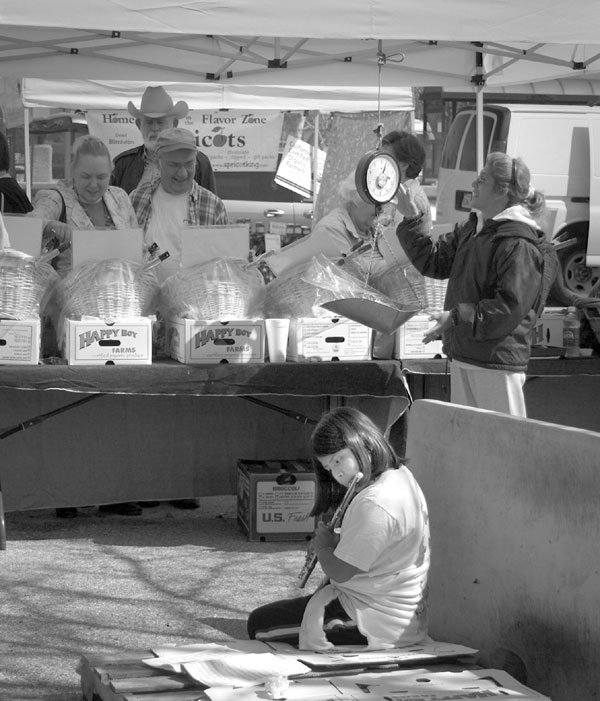Late March is a romantic time of year for area farmers. The
cherry trees are blossoming, crops are full of promise and growers
on the cutting edge of the tourist industry can look forward to a
season of tastings and tours, a new approach to agribusiness that
they’re learning from the wine industry.
Late March is a romantic time of year for area farmers. The cherry trees are blossoming, crops are full of promise and growers on the cutting edge of the tourist industry can look forward to a season of tastings and tours, a new approach to agribusiness that they’re learning from the wine industry.
Don Hordness would love to imagine hordes of day-trippers visiting Royal Oaks Mushrooms in Morgan Hill, spreading red and white checkered cloths on the ground and losing themselves in piles of portabellas and browns, but he can’t.
“I think agri-tourism is a great idea, but I don’t know how mushrooms fit into that,” Hordness said recently. “It’s kind of hard to eat a box of mushrooms with a loaf of bread, but if people did, I would do it. A way agriculture can stay strong is to have those kind of outlets.”
It seems that agriculture loses more ground every year to industry and home development in what used to be known as the Valley of the Heart’s Delight. More and more, farmers are discovering that the old way of doing business – pack off your harvest to a shipper who will sell it around the world – isn’t enough to stay solvent in a market increasingly dominated by lesser quality and cheaper imports.
Farmers have to find new ways to get their products in the hands and mouths of consumers.
Mushrooms are coming in greater numbers from China and Mexico, but Canada is Hordness’ biggest foreign competitor. Canadian mushrooms are better quality than the others, but the country has a tendency to flood the U.S. market and drive down prices of local goods.
“It’s pretty tough,” Hordness said. “There’s not a lot we can do except grow more pounds and try to keep costs down.”
Hordness at least has the benefit of farming a crop that can be grown year-round. About 8,500 square-feet of mushroom are planted every week in greenhouses at the Royal Oaks facility on Watsonville Road. It takes about 45 days for them to mature and then be put on sale at a walk-up window at the farm. Hordness also sells compost directly to consumers.
And while he can’t offer an idyllic day out at the farm, he does offer customers what he says are the best mushrooms they can find.
“I’m trying to get people to buy California grown and to recognize that it’s important that they support local agriculture,” Hordness said. “If local agriculture is gone that they’re at the mercy of other countries who don’t have the same restrictions on chemicals and how they treat their people.”
Hordness slaps California-grown labels on his mushrooms, but hasn’t done much to attract more tourist traffic to his farm, which does about 5 percent of its business at the walk-up window.
Marketing and direct sales, however, are catching on up and down the valley. Many growers are turning to a vintner-like business model and cutting out middle men whenever they can. Those farmers hope they can tap a desire for fresh, locally grown produce and curiosity about farming.
Peggy Miars, president of California Certified Organic Growers in Santa Cruz, said recently that as gourmet food trends spread across the county, city folk want to know where their food comes from.
“Consumers are interested in learning more about farming,” Miars said. “Back in the 1800’s people grew their own food and raised their own livestock, but now it’s a total mystery. People, especially from the city, don’t have a clue how a carrot is grown. It’s amazing how excited people get when they can actually pull one out of the ground themselves. It’s a very fun experience for them.”
Farmers markets, where small, family operations can promote their produce and build customer loyalty, are proliferating in the Bay Area. Morgan Hill’s farmers market now is open year-round, from 9am to 1p.m. in the Caltrain lot at Third and Depot streets.
In the summer, Dick and Bonnie Swank travel all over the region with heirloom tomatoes, cherries and super sweet corn. In a given week during harvest time you can find Swank Farms produce in San Jose, Mountain View, Pleasanton, Milpitas and Monterey County.
“It’s the only thing that’s keeping us alive,” Swank said recently from his Hollister farm. “The wholesale market is just dead. When you sell directly to stores, they tend to be fair, but wholesalers will just kill you.”
The Swanks sell to PW Supermarkets, and this summer they’ll reopen the stand they used to maintain at their 120 acre farm, where they also grow lettuce, gourds and pumpkins.
The Swanks first ran a farm stand in the early 1990’s, but shut it down when the traffic that used pass by the farm was diverted by the Highway 156 bypass, rendering Swank farms “kind of out of the way” on San Felipe Road.
In the fall, the Swanks cut a corn maze in their fields and host school kids at the pumpkin patch. The maze draws visitors from throughout the Central Coast.
Swank sees kids as key to keeping his farm profitable. He and his wife are putting together learning kits that they’ll drop off at area schools. He wants to have schools sponsor field trips in the spring and each kids how to plant pumpkins. Those who come out in May will get a coupon for a free pumpkin in October.
“Our goal is to get some more kids here to help them experience agriculture,” Swank said. “Kids come for field trips in October, but the growing season is pretty much over.”
A short season is also a challenge for the growers at LJB Farms on the border of Gilroy and San Martin. The farm has a popular store, but it’s only open half the year, from June through Christmas. Russ Bonino said the pressures to stay competitive are taking a toll on the land, making it even more difficult to get consistent high-quality crops, especially for farmers with three-month growing seasons.
“The general public doesn’t understand how much the weather affects us,” Bonino said. “The playing field is not level here, and that’s where we run into problems. We have to double- and triple-crop. Our ground is tired; it’s been intensively cultivated for more than 100 years.”
The Bonino family has farmed the land at Fitzgerald and Monterey on the Gilroy-San Martin border for four generations. Bonino jokes about selling out, but said “it’s tough to say whether we would, we’ve been here since 1917.”














